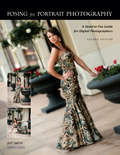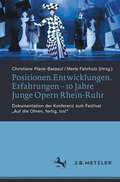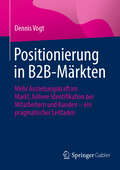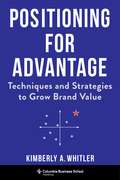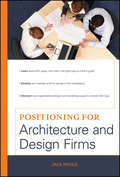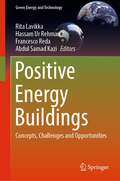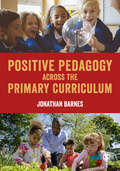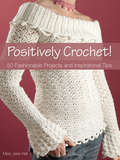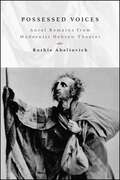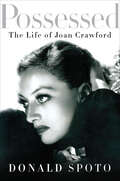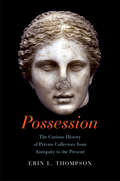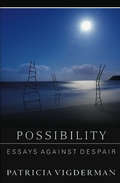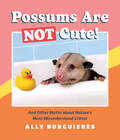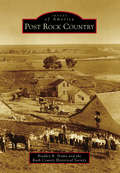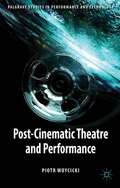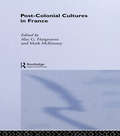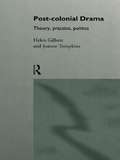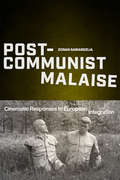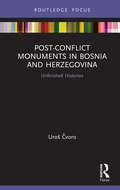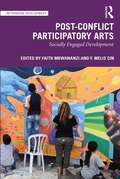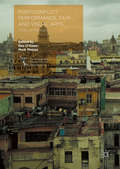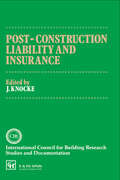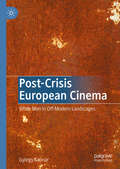- Table View
- List View
Posing for Portrait Photography: A Head-to-Toe Guide
by Jeff SmithPhotographers learn how to gauge the needs of their clients before placing them into a stale, preconceived #147;women’s,” #147;men’s,” or #147;children’s” pose that hardly fits the client’s personality or preferences. Provided with a two-pronged approach to fail-safe posing, photographers learn first to determine what the mood of the portrait should be and how to use an appropriate posing genre#151;traditional, casual, glamour, or journalistic. Photographers are then shown how that genre can be used as a basis to produce a pose that best suits the client, allowing them to create dynamic yet natural-looking pose that the subject#151;and the intended recipient#151;will love.
Positionen.Entwicklungen.Erfahrungen – 10 Jahre Junge Opern Rhein-Ruhr: Dokumentation der Konferenz zum Festival „Auf die Ohren, fertig, los!“
by Christiane Plank-Baldauf Merle FahrholzHören, Sehen, Staunen – in den deutschsprachigen Opernhäusern kann junges Publikum seit über zehn Jahren viel entdecken! Die vorliegende Dokumentation fasst die Ergebnisse der Konferenz „Auf die Ohren, fertig los!“ der Jungen Opern Rhein-Ruhr zusammen und gibt Einblicke in künstlerische Produktionsbedingungen, ästhetische Handschriften, Vermittlungsarbeit, institutionelle Rahmenbedingungen und fokussiert aktuelle Uraufführungen des Kooperationsverbunds. Die Ergebnisse der Konferenz werden zudem in einen übergreifenden Kontext gesellschafts- und kulturpolitischer Entwicklungen im Musiktheater für junges Publikum im deutschsprachigen Raum gestellt.
Positionierung in B2B-Märkten: Mehr Anziehungskraft im Markt, höhere Identifikation bei Mitarbeitern und Kunden – ein pragmatischer Leitfaden
by Dennis VogtDieses Buch bietet eine pragmatische Anleitung für die Entwicklung und konsequente Umsetzung einer klaren Positionierung in B2B-Märkten. Eine Positionierung, die sich über das gesamte Leistungsspektrum sowie über alle Kontaktpunkte mit Zielgruppen erstreckt und zudem die Mitarbeitenden mitnimmt. Der Autor beleuchtet im ersten Schritt die zentralen Mechanismen, die Zielgruppen im Zuge von Kaufentscheidungsprozessen in B2B-Märkten beeinflussen. Im zweiten Schritt zeigt er, wie B2B-Anbieter eine wirkungsvolle Positionierung mit klarer Differenzierung erarbeiten können. Im dritten Schritt wird aufgezeigt, wie B2B-Anbieter diese Positionierung konsequent über ihr gesamtes Leistungsspektrum sowie alle relevanten Kontaktpunkte mit Zielgruppen aktivieren können. Im vierten und letzten Schritt geht es darum, wie B2B-Anbieter ihre Positionierung in den Köpfen und Prozessen der eigenen Organisation konsequent verankern können. Nur so kann der nachhaltige Markterfolg gelingen. Erfolgreiche B2B-Unternehmen haben erkannt: die fortschreitende Globalisierung, die permanent zunehmende Digitalisierung, und die rasante Zunahme an Innovationen zwingt zu einem fokussierten Marktauftritt. Dieser muss mit überzeugenden Produkt- und Service-Leistungen und ebenso überzeugenden Erlebnissen für die Kunden an jedem Touchpoint unter Beweis gestellt werden. Wie diese Fokussierung in der Strategie-Entwicklung und der internen und externen Kommunikation gelingt, zeigt dieses Buch.
Positioning for Advantage: Techniques and Strategies to Grow Brand Value
by Professor Kimberly A. WhitlerMost of us have an intuitive sense of superior branding. We prefer to purchase brands we find distinctive—that deliver on some important, relevant dimension better than other brands. These brands have typically achieved positional advantage. Yet few professionals have had the formal training that goes beyond marketing theory to bridge the “theory-doing gap”—understanding the specific techniques and strategies that can be used to create brands that attain positional advantage in the marketplace.Positioning for Advantage is a comprehensive how-to guide for creating, building, and executing effective brand strategies. Kimberly A. Whitler identifies essential marketing strategy techniques and moves through the major stages of positioning a brand to achieve in-market advantage. Introducing seven tools—from strategic positioning concepts to strategy mapping to influencer maps—Whitler provides templates, frameworks, and step-by-step processes to build and manage growth brands that achieve positional advantage. This book presents real-world scenarios, helping readers activate tools to increase skill in creating brands that achieve positional advantage. Brimming with insights for students and professionals alike, Positioning for Advantage helps aspiring C-level leaders understand not only what superior branding looks like but also how to make it come to life.
Positioning for Architecture and Design Firms
by Jack ReigleAn essential guide for a firm of any size to effectively position itself in the marketplace For an architecture or design firm to survive and prosper in the new economy, it needs to redefine and reinvigorate its position in the marketplace. With dozens of how-to cases, examples, and guidelines, Positioning for Architecture and Design Firms provides the entire menu of tools, plus the inspiration needed, for making the changes required to stay competitive in the design world. Offering strategies for leveraging a firm's strongest assets into the formulation of a successful long-term plan, this book breaks with tradition to introduce the latest concepts specifically developed for building future business opportunities in an unstable economic landscape marked by shifts in competition, technology, and client expectations. With a wealth of information targeting the subject of positioning, readers will learn: Why the aftershocks of the Great Recession are likely to linger, and what you can do about it in relation to your firm's success How the coming generational shift will change the design business What positioning is, and how it needs to be developed to support and implement your strategic vision How your firm can establish a robust identity and operating model The importance of your firm's essential purpose How to turn your marketing department into a true marketing system, transforming it from production mode into an integrated positioning machine Why it is important to engage in advanced research and open innovation initiatives Addressing issues of firm identity, including an understanding of how to create the market positioning desired, Positioning for Architecture and Design Firms shows how a design firm-large or small, new or well established-can position itself to gain greater control over its destiny, and reach loftier levels of achievement. Learn about firm types, and match the right type to a firm's goals Develop and maintain a firm's identity in the marketplace Discover how organizational design and marketing support a chosen firm type
Positive Energy Buildings: Concepts, Challenges and Opportunities (Green Energy and Technology)
by Francesco Reda Rita Lavikka Hassam Ur Rehman Abdul Samad KaziThis book investigates positive energy buildings (PEBs). It provides and describes them, explains why they are important in the fight against climate change and discusses how they might be implemented. This book begins by contextualizing PEBs, discussing concepts, definitions and how they may be included by planning authorities in development plans. It then thoroughly explains what PEBs are and their impact on a climate-neutral economy. The book discusses technological, economic, societal and regulatory challenges and opportunities in employing PEBs, before concluding with possible scenarios for implementing them. This book is of use to researchers, practitioners, and policy makers interested in local and decentralized energy, as well as plans to achieve carbon neutrality.
Positive Pedagogy across the Primary Curriculum
by Jonathan BarnesThis book offers a positive approach to thematic cross-curricular teaching. Within a clear focus on humanitarian and inclusive values, it offers guidance on robust learning in the subject disciplines within a set of highly involving themes. Its fundamental aim is the mental, physical, social and intellectual wellbeing of children and their teachers. Discover how your teaching can support genuine age-appropriate engagement in contemporary and global issues like shared values, anti-racism, social inequalities and environmental concerns. Learn ways of drawing from a wider, inclusive and motivating curriculum without compromising progression in subject-specific learning. Case studies and clear guidance on planning and assessment offer strong practical advice to support you in setting the foundations for smart, informed and relevant primary school teaching. Jonathan Barnes is a Visiting Senior Research Fellow at Canterbury Christ Church University and a National Teaching Fellow.
Positive Pedagogy across the Primary Curriculum
by Jonathan BarnesThis book offers a positive approach to thematic cross-curricular teaching. Within a clear focus on humanitarian and inclusive values, it offers guidance on robust learning in the subject disciplines within a set of highly involving themes. Its fundamental aim is the mental, physical, social and intellectual wellbeing of children and their teachers. Discover how your teaching can support genuine age-appropriate engagement in contemporary and global issues like shared values, anti-racism, social inequalities and environmental concerns. Learn ways of drawing from a wider, inclusive and motivating curriculum without compromising progression in subject-specific learning. Case studies and clear guidance on planning and assessment offer strong practical advice to support you in setting the foundations for smart, informed and relevant primary school teaching. Jonathan Barnes is a Visiting Senior Research Fellow at Canterbury Christ Church University and a National Teaching Fellow.
Positively Crochet!: 50 Fashionable Projects and Inspirational Tips
by Mary Jane HallPositively Crochetlives up to its name with plenty of crochet projects and powerful messages for positive living. This playful, project-focused guide concentrates on the patterns and stitches used to design the 50+ fashionable projects in this book, which include scarves, shrugs, sweaters, hats, purses and belts. In addition to trendy garments and accessories, you will discover pairings of design tips with inspirational insight, useful for improving crochet skills and making the most of every situation life delivers.
Possessed Voices: Aural Remains from Modernist Hebrew Theater (SUNY series in Contemporary Jewish Literature and Culture)
by Ruthie AbeliovichFinalist for the 2020 Jordan Schnitzer Book Award in the category of Jews and the Arts: Music, Performance, and Visual presented by the Association for Jewish StudiesPossessed Voices tells the intriguing story of a largely unknown collection of audio recordings, which preserve performances of modernist interwar Hebrew plays. Ruthie Abeliovich focuses on four recordings: a 1931 recording of The Eternal Jew (1919/1923), a 1965 recording of The Dybbuk (1922), a 1961 radio play of The Golem (1925), and a 1952 radio play of Yaakov and Rachel (1928). Abeliovich traces the spoken language of modernist Hebrew theater as grounded in multiple modalities of expressive practices, including spoken Hebrew, Jewish liturgical sensibilities supplemented by Yiddish intonation and other vernacular accents, and in relation to prevalent theatrical forms. The book shows how these recorded performances provided Jewish immigrants from Europe with a venue for lamenting the decline of their home communities and for connecting their memories to the present. Analyzing sonic material against the backdrop of its artistic, cultural, and ideological contexts, Abeliovich develops a critical framework for the study of sound as a discipline in its own right in theater scholarship.
Possessed: The Life of Joan Crawford
by Donald SpotoJoan Crawford was one of the most incandescent film stars of all time, yet she was also one of the most misunderstood. In this brilliantlyresearched, thoughtful, and intimate biography, bestselling author Donald Spoto goes beyond the popular caricature—the abusive, unstable mother portrayed in her adopted daughter Christina Crawford’s memoir, Mommie Dearest—to give us a three-dimensional portrait of a very human woman, her dazzling career, and her extraordinarily dramatic life and times.Based on new archival information and exclusive interviews, and written with Spoto’s keen eye for detail, Possessed offers a fascinating portrait of a courageous, highly sexed, and ambitious womanwhose strength and drive made her a forerunner in the fledgling film business. From her hardscrabble childhood in Texas to her early days as a dancer in post–World War I New York to her rise to stardom,Spoto traces Crawford’s fifty years of memorable performances in classics like Rain, The Women, Mildred Pierce, and Sudden Fear, which are as startling and vivid today as when they were filmed.In Possessed, Spoto goes behind the myths to examine the rise and fall of the studio system; Crawford’s four marriages; her passionate thirty year, on-and-off-again affair with Clark Gable; her friendships and rivalries with other stars; her powerful desire to become a mother; the truth behind the scathing stories in her daughter Christina’s memoir; and her final years as a widow battling cancer. Spoto explores Crawford’s achievements as an actress, her work with Hollywood’s great directors (Frank Borzage, George Cukor, Otto Preminger) and actors (Henry Fonda, James Stewart, Spencer Tracy, John Barrymore), and later, her role as a highly effective executive on the board of directors of Pepsi-Cola.Illuminating and entertaining, Possessed is the definitive biography of this remarkable woman and true legend of film.
Possession: The Curious History of Private Collectors from Antiquity to the Present
by Erin ThompsonWhether it's the discovery of $1. 6 billion in Nazi-looted art or the news that Syrian rebels are looting UNESCO archaeological sites to buy arms, art crime commands headlines. Erin Thompson, America's only professor of art crime, explores the dark history of looting, smuggling, and forgery that lies at the heart of many private art collections and many of the world's most renowned museums. Enlivened by fascinating personalities and scandalous events, Possession shows how collecting antiquities has been a way of creating identity, informed by a desire to annex the past while providing an illicit thrill along the way. Thompson's accounts of history's most infamous collectors--from the Roman Emperor Tiberius, who stole a life-sized nude Greek statue for his bedroom, to Queen Christina of Sweden, who habitually pilfered small antiquities from her fellow aristocrats, to Sir William Hamilton, who forced his mistress to enact poses from his collection of Greek vases--are as mesmerizing as they are revealing.
Possibility: Essays Against Despair
by Patricia Vigderman"Reading Patricia Vigderman is like attending an ideal dinner party, where everyone has read your favorite books. Her essays wind particular passages of Proust, or George Eliot, or W.G. Sebald around personal moments; David Foster Wallace's story 'The Depressed Person' is threaded throughout an essay about her own relationship with a loved one's serious depression. Vigderman's responses are fresh and original and her sounding of our collective literary treasures are likely to send you back to read them again, now overlaid with her embroidery."-Mona SimpsonIn this accessible collection of essays, Patricia Vigderman attempts to translate some of life's disordered events into the orderly happiness of art. She encounters manatees, children, and snakes; with Henry Adams, Marcel Proust, and W.G. Sebald; with Texas landscape, Vertigo, and Johannes Vermeer. Adams, in Japan after his wife's death, found in the elaborate ritual of the tea ceremony and in the discomforts of a rural inn, occasions for the wit to face down grief. His letters to friends coax laughter from strangeness and loss. Like Adams, Vigderman has a stylist's passion for revelatory detail, and for the pleasure of immersion in a world. Smart, generous, and probing, her discoveries play with direct experience, exploring the interaction of life and art as "magic you can walk in and out of."Patricia Vigderman's work has appeared in The Nation, The New York Times, Georgia Review, Raritan, and others. She was a Literature Fellow at the Liguria Center for the Arts and Humanities in Italy and teaches at Kenyon College.
Possums Are Not Cute!: And Other Myths about Nature's Most Misunderstood Critter
by Ally BurguieresPossums may steal your garbage…but with this book, they&’ll also steal your heart!Possums are more than the ugly-cute icons of the internet. These so-called trash animals and pointy kitties are not only relatable avatars for anxious but resilient people everywhere, but nature&’s secret clean-up crew. Organized around common myths that have given possums a bad reputation, this fun and offbeat book reveals the truth about possums through dozens of adorable photos, informative illustrations, and fascinating facts. Did you know that… • Possums protect people and pets from disease! A single possum can eat up to 4,000 ticks per week! • Possums excel at interspecies friendships, often sleeping in other animals&’ dens. • Possums are shy creatures: when they &“play dead,&” they are actually fainting from anxiety! Written by wildlife rehabber and possum advocate Ally Burguieres, known for her popular Instagram account @ItsMeSesame, this accessible and giftable guide explains why possums deserve our admiration and offers tips on how we can protect and advocate for these magical marsupials.
Post Cards from Space: In September
by Lawrence Wright"A magnificent book [from] one of our finest nonfiction writers. . . . In his minute-by-minute account of the talks Wright intersperses a concise history of Egyptian-Israeli relations dating from the story of Exodus. Even more important is Wright's understanding that Sadat, Begin and Carter were not just political leaders, but exemplars of the Holy Land's three internecine religious traditions
Post Rock Country (Images of America)
by Rush County Historical Society Bradley R. PenkaRush County, at the south end of Post Rock Country, was organized on December 5, 1874, and named in honor of Capt. Alexander Rush, Company H, of the 2nd Kansas Colored Infantry. The first settlers arrived in 1869 and established homesteads along Walnut Creek near the Fort Hays-Fort Dodge Trail. With few trees on the vast, dry prairie, settlers searched for alternative building materials. Post Rock, a unique limestone bed that sat within inches of the surface, was so well used and became such a curiosity that it gave rise to the Post Rock Museum in 1963.
Post-Cinematic Theatre and Performance
by Piotr WoycickiA cinema without cameras, without actors, without screen frames and without narratives almost seems like an antithetical impossibility of what is usually expected from a cinematic spectacle. This book defines an emergent field of post-cinematic theatre and performance, challenging our assumptions and expectations about theatre and film.
Post-Colonial Cultures in France
by Alec Hargreaves Mark McKinneyEthnic minorities, principally from Africa, Asia, the Caribbean and the surviving remnants of France's overseas empire, are increasingly visible in contemporary France. Post-Colonial Cultures in France edited by Alec Hargreaves and Mark McKinney is the first wide-ranging survey in English of the vibrant cultural practices now being forged by France's post-colonial minorities. The contributions in Post-Colonial Cultures in France cover both the ethnic diversity of minority groups and a variety of cultural forms ranging from literature and music to film and television. Using a diversity of critical and theoretical approaches from the disciplines of cultural studies, literary studies, migration studies, anthropology and history, Post-Colonial Cultures in France explores the globalization of cultures and international migration.
Post-Colonial Drama: Theory, Practice, Politics
by Helen Gilbert Joanne TompkinsPost-Colonial Drama is the first full-length study to address the ways in which performance has been instrumental in resisting the continuing effects of imperialism. It brings to bear the latest theoretical approaches from post-colonial and performance studies to a range of plays from Australia, Africa, Canada, New Zealand, the Caribbean and other former colonial regions. Some of the major topics discussed in Post-Colonial Drama include: * the interactions of post-colonial and performance theories * the post-colonial re-stagings of language and history * the specific enactments of ritual and carnival * the theatrical citations of the post-colonial body Post-Colonial Drama combines a rich intersection of theoretical approaches with close attention to a wide range of performance texts.
Post-Communist Malaise: Cinematic Responses to European Integration (Media Matters)
by Zoran SamardzijaThe collapse of communism in the Soviet Union and Eastern Europe was supposed to bring about the “end of history” with capitalism and liberal democracy achieving decisive victories. Europe would now integrate and reconcile with its past. However, the aftershocks of the financial crisis of 2008—the rise in right-wing populism, austerity politics, and mass migration—have shown that the ideological divisions which haunted Europe in the twentieth century still remain. It is within this context that Post-Communist Malaise revives discourses of political modernism and revisits debates from Marxism and seventies film theory. Analyzing work of Theo Angelopoulos, Vera Chytilová, Srdjan Dragojevic, Jean-Luc Godard, Miklós Jancsó, Emir Kusturica, Dušan Makavejev, Cristi Puiu, Jan Švankmajer, Andrei Tarkovsky, and Béla Tarr, the book focuses on how select cinemas from Eastern Europe and the Balkans critique the neoliberal integration of Europe whose failures fuel the rise of nationalism and right-wing politics. By politicizing art cinema from the regions, Post-Communist Malaise asks fundamental questions about film, aesthetics, and ideology. It argues for the utopian potential of the materiality of cinematic time to imagine a new political and cultural organization for Europe.
Post-Conflict Monuments in Bosnia and Herzegovina: Unfinished Histories (Routledge Focus on Art History and Visual Studies)
by Uroš ČvoroAt a time of dramatic struggles over monuments around the world, this book examines monuments that have been erected in post-conflict Bosnia and Herzegovina (BiH) since 1996. Examining the historical precedents for the high rate of monumentbuilding, and its links to ongoing political instability and national animosity, this book identifies the culture of remembrance in BiH as symptomatic of a broader shift: a monumentalisation and privatisation of history. It provides an argument for how to account for the politics of contemporary nation-state formation, control of space, trauma and revisions of history in a region that has been subject to prolonged instability and crisis. This book will be of interest to scholars in contemporary art, museum studies, war and conflict studies, and European studies.
Post-Conflict Participatory Arts: Socially Engaged Development (Rethinking Development)
by Faith MkwananziThis book investigates the power of art to enhance human development and to initiate positive social change for individuals and societies recovering from conflict. Interventions aimed at reinforcing social justice and bringing communities together after conflict are often accused of being top-down, or failing to consider all groups and contexts within a society. The use of participatory arts can help to address these challenges by fostering community engagement, social cohesion, influencing public policy, and ultimately, advancing social justice. Arts-based methods can be particularly effective at reaching youth communities, providing voice and political agency to young people who are often not given a platform. Situated at the intersection of participatory arts, social and epistemic justice, this book brings together case studies from across the world to reflect on best practice for the use of bottom-up, participatory, co-produced, and co-designed arts processes in conflict settings. This book provides an important guide to the role that arts can play in addressing epistemic injustice and contributing to social justice and human development. As such, it will be of interest to international development and arts practitioners, policy makers, and to students and researchers across participatory arts, youth studies, international development, social justice, and peace and conflict studies.
Post-Conflict Performance, Film and Visual Arts
by Des O'Rawe Mark PhelanDrawing on a range of cities and conflicts from Europe, Africa and the Middle East, the collection explores the post-conflict condition as it is lived and expressed in modern cities such as Berlin, Belfast, Bilbao, Beirut, Derry, Skopje, Sarajevo, Tunis, Johannesburg and Harare. Post-Conflict Performance, Film and Visual Arts: Cities of Memory investigates how the memory of conflict can be inscribed in historical monuments, human bodies and hermeneutic acts of mapping, traversing, representing, and performing the city. Several essays explore the relations between memory, history and urban space; where memory is located and how it is narrated, as well as various aspects of embodied memory; testimonial memory; traumatic memory; counter-memory; false memory; post-memory. Other essays examine the representations of post-war cities and how cultural imaginations relate to the politics of reconstruction in places devastated by protracted urban warfare. Post-Conflict Performance, Film and Visual Arts: Cities of Memory offers a comparative survey of the complex and often controversial encounters between public art, political memory and commemoration in divided societies, as well as offering insights into the political and ethical difficulties of balancing the dynamics of forgetting and remembering.
Post-Construction Liability and Insurance
by J. KnockeWith the single European market and the growing internationalisation of the work of architects, engineers and contractors it is important for professionals to be aware of the liability provisions of legal systems around the world. An essential reference for lawyers and insurance companies, especially in construction law and insurance, this is required reading for construction professionals involved in international work.
Post-Crisis European Cinema: White Men in Off-Modern Landscapes
by György KalmárThis book explores the cinematic representations of the pervasive socio-cultural change that the 21st century brought to Europe and the world. Discussing films such as I, Daniel Blake, Cold War and Jupiter’s Moon, it puts distinctively “post-crisis”, gendered representations in a complex, theoretically informed and socially committed interdisciplinary perspective that maps the newly emerging formations of masculinity at a time of rapid socio-economic transition. Kalmar argues that the series of crises that started with the 9/11 terrorist attacks changed some of our fundamental expectations about history, debunked many of our grand narratives, and thus changed the cultural logic of our (thoroughly globalized) civilization. The book focuses on the ways cinema reflects, interprets and shapes a rapidly changing world: the hot issues of the times, the new formations of identity, and the shifts in cinematic representation. This is an interdisciplinary research that is equally interested in what new the 21st century brought about, most specifically to Europe and to its white men, as in film and its responses to these socio-cultural changes.
